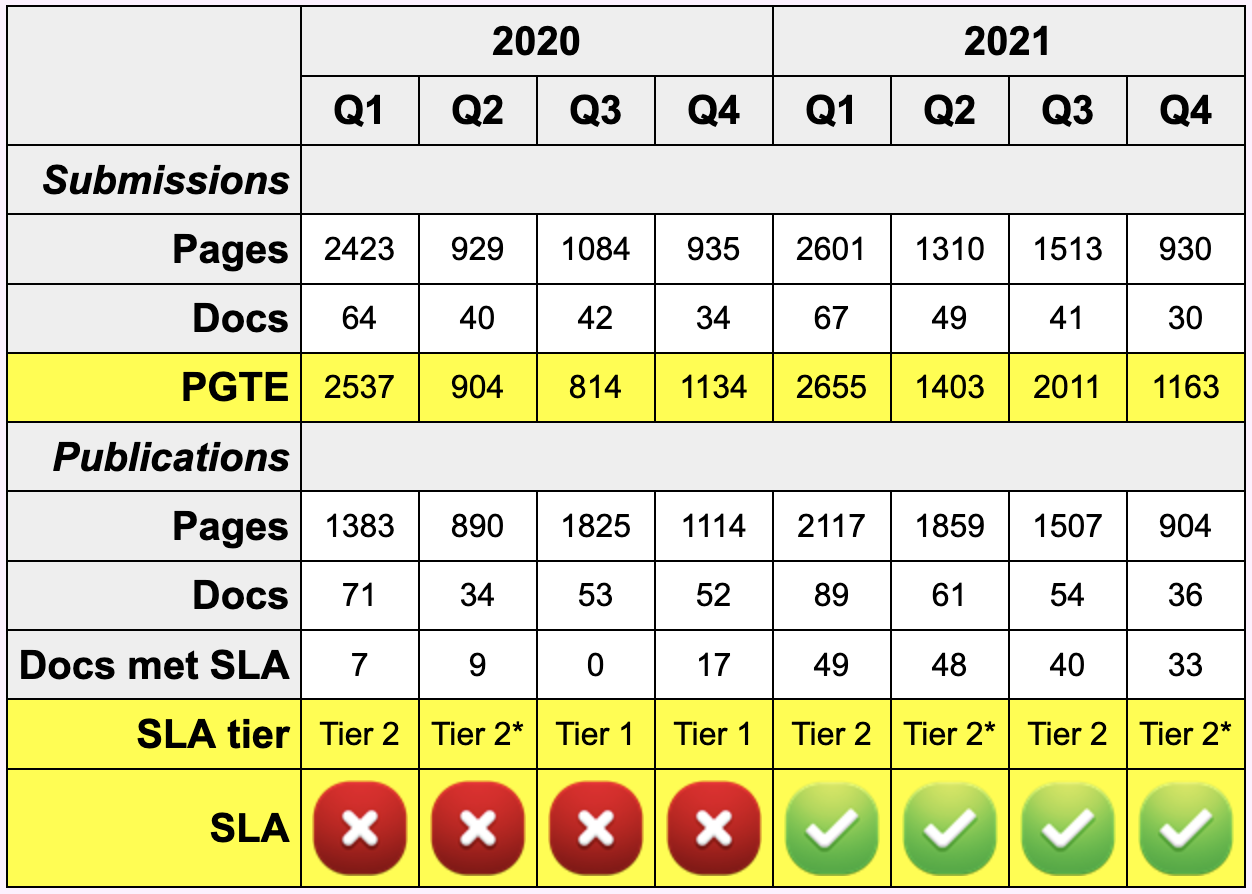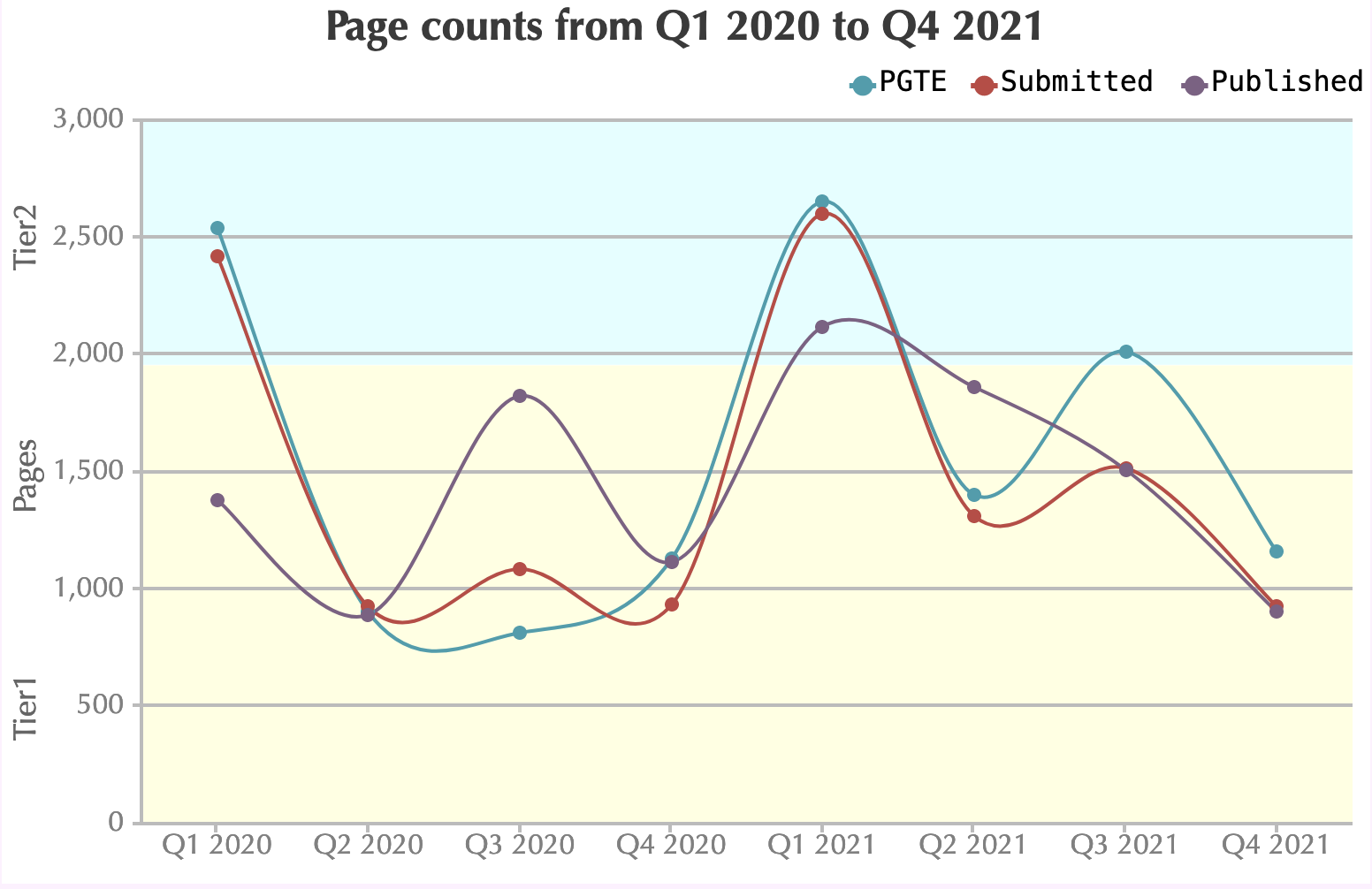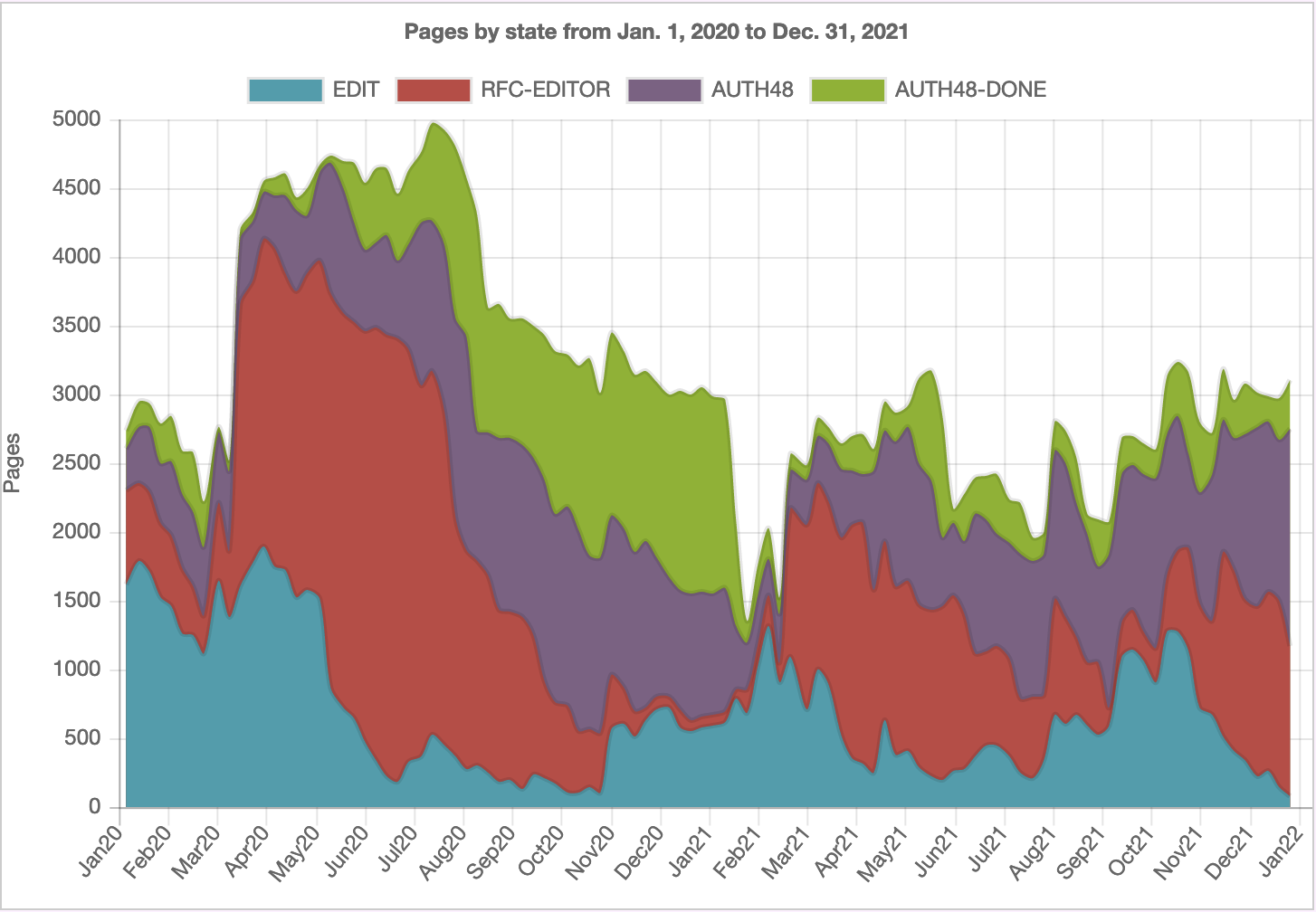Report Summary 2021
This page contains useful information regarding the performance of the RFC Production Center (RPC). It includes news items (updated as needed) and stats about production that are updated on a quarterly basis.
The RFC Editor strives to provide excellent and timely editorial service. To ensure the RFC Editor is providing the best possible service, the RPC regularly reviews its processes and liaises with the communities served. In addition, the rfc-interest mailing list is dedicated to discussing topics related to the RFC Editor.
Table of Contents
Service Level Agreement
The Service Level Agreement indicates the following:
- Tier 1: When there is a normal amount of input, the SLA is 67% of documents published within the period have an RFC Editor-controlled time that adds up to six weeks or fewer. Where ‘normal’ is defined as less than 1950 Pages gone to EDIT (PGTE).
- Tier 2: When there is a moderate burst in the amount of input, then the SLA shifts to 50% of documents published within the period have an RFC Editor-controlled time that adds up to 12 weeks or fewer within the given quarter or the subsequent quarter. Where a ‘moderate’ burst is defined as 1950 – 3072 (inclusive) Pages gone to EDIT (PGTE).
- Tier 3: When there is a large burst in the amount of input, then the SLA must be discussed and renegotiated. Where ‘large’ burst is defined as greater than 3072 Pages gone to EDIT (PGTE).
The figures below indicate whether we are meeting this goal.
“Tier 2*” indicates when Tier 2 is being applied in the “subsequent quarter” as mentioned above. The gray boxes denote the period during which the SLA has been suspended because of the v3 transition.
Figure 1. SLA Summary
Figure 2. PGTE and Pages Submitted & Published (by Quarter)
Figure 3. Number of Pages in Primary Processing States (i.e., no third-party holds)
Note that PGTE provides a more accurate picture of the RPC’s incoming workload for a given time period (than the number of documents entering the queue).
Also note that there is a ripple effect, as spikes in document counts in any one state may be due to clusters of documents moving through the queue together. A cluster does not move to the next state until the entire set is ready to be moved. You will often see bursts in EDIT, then RFC-EDITOR, and finally PUB, as the set of documents move through the states together to publication.
Generally speaking, the more documents there are in the queue, the longer it takes for documents to move through the queue.
Notes
2021: In 2021, the RPC published 240 RFCs (6387 pages) and successfully met the Service Level Agreement for the first time since transitioning to v3 XML in September 2019 (see Figure 1). This is a 14% increase in the number of documents published in 2020, and a 23% increase in page counts. This means the documents published in 2021 were, on average, slightly longer than those published in 2020.
Q3 2021: 54 RFCs were published in Q3; 33% were part of a cluster. Only 41 Internet-Drafts entered the edit queue this quarter, but they are the equivalent of 77 average size RFCs. The I-Ds entering the queue were approximately 40% longer than the average published RFC over the last 5 years.
The RPC initiated the next round of the experiment to use GitHub during AUTH48. This involved significantly modifying the workflow from previous rounds of the experiment. This is a limited experiment; details will be reported once the experiment is complete.
Also, the RPC continued to track rfced-future discussion (see the mailing list) and participate in the v3 XML and Style Guide change management team.
Q2 2021: 49 Internet-Drafts (1403 pages) were added to the publication queue and 61 RFCs (1859 pages) were published in Q2. PGTE returned to the normal range after exploding in Q1, where PGTE was the highest it has been since 2015. Figure 2 shows the decrease in submissions from Q1 and the steady rate of publications this year. Figure 3 shows that the workload in the various states remains relatively stable so far in 2021 and resembles the queue size just prior to the transition to v3 XML.
With the Streams’s adoption of “Guidance for NIST Staff on Using Inclusive Language in Documentary Standards”, the RFC Editor encourages all authors to apply the guidance described in that document when writing and editing their documents. The RPC will ask authors to review the language in their documents, though changes will are not required. (See the IESG Statement on Inclusive Language for more information.)
In addition to document throughput, the RPC continues to work with the v3 XML and Style Guide change management team to review and discuss potential changes to the “RFC XML and Style Guide”.
Q1 2021: 89 RFCs were published in Q1, about half of which were part of C238.
Figure 3 shows when they were published in January as the number of documents (and page counts) declined sharply. Subsequently, the queue grew significantly, as the largest number of documents (and page counts) in two years moved into the EDIT queue (234% increase over the previous quarter). Figure 2 shows the sizable increase in documents submitted, moved to EDIT, and published.
In addition to document throughput, the RPC continues to work with the
Q4 2020: With 209 RFCs published in 2020, and much of C238 in AUTH48-DONE (or nearing AUTH48-DONE), we’re seeing a return to more normal processing times. 33% of the documents were published in 6 weeks or less (Tier 1). This is a significant improvement from earlier quarters in the year.
Throughout the year, 209 RFCs were published. 35% of the documents were associated with a cluster. 26% of the RFCs were published within Tier 2 goals.
Note: A majority of the 50 documents comprising C238 have extended processing times, so we do not expect the improved processing times to be reflected in the SLA until Q2 of 2021 (i.e., after C238 has been published).
Q3 2020: We are a year out from transitioning to v3 XML and most issues have been resolved. We are starting to see a change in processing times, despite what Figure 1 is showing.
In Q3 of 2020, 23% of the RFCs published were within the Tier 2 processing times; so far in Q4 (October), 58% of the documents are being published within Tier 2 processing times. Note that we do not expect to meet the SLA this quarter as older documents finally clear out of the queue (in particular, if C238 is published), but we are returning to normal processing times.
As noted in Figure 2, publications have outpaced document submissions, which indicates that the queue size is decreasing. In addition, Figure 3 shows a significant drop in pages pending RFC Editor action, and fewer pages in any active state overall.
Q2 2020: There was a submission spike at the end of Q1, which is not unexpected when there is IESG changeover. As shown in Figure 3, there was also a spike in the number documents in RFC-EDITOR state. This is because the major3ity of C238 (40+ documents) and the 600+ page draft-ietf-nfsv4-rfc5661sesqui-msns moved into RFC-EDITOR state. The RPC is actively working on releasing C238 to AUTH48.
Q1 2020: We said goodbye to Heather Flanagan, who had been the RFC Series Editor since 2012, and welcomed John Levine as the Temporary RFC Series Project Manager.
As previously mentioned, the team is converting files to v3 XML as part of the editorial process. As files are converted, we continue to report bugs to the developer and seek guidance from various parties about the “right” way to format and tag some text (e.g., <artwork> or <sourcecode>).
Publications were slow in January. This is largely because C388 (14 IASA2 docs) didn’t complete AUTH48. Also, some staff time has been dedicated to C238 (41 active docs); portions of C238 will begin moving to AUTH48 shortly.
The RFC search results and info pages now have links to HTML files with inline errata, when available (these files exist for RFCs that have verified errata). For example: https://www.rfc-editor.org/search/rfc_search_detail.php?rfc=5234 links to https://www.rfc-editor.org/rfc/inline-errata/rfc5234.html.
Other Reports
| Report | Description |
|---|---|
| Current Queue (sortable) | A list of all of the documents in the RFC Editor queue, ordered by state. (Updated dynamically) |
| Queue Summary | RFC Editor queue summary (Updated weekly) |
| Comprehensive Sub/Pub Stats | Detailed submission and publication data |
| Reports Archive | Pre-2014 reports (Was updated monthly) |
| Annual Publication Rate | Bar graph showing the number of RFCs published per year since 1969. (Updated annually). |
| RFC Editor Reports at IETF | Summary of the RFC publication process, including the state of the queue and a breakdown of the reasons for any long delays in the publication process. The report also may include recent changes in policy and improvements in tools or procedures. (Updated quarterly) |
| RFC Errata Reports | Summary of errata reports and their status, stream, and type. |
| RFC Status Changes (post-publication) | List of the RFCs whose statuses have changed since publication. (Updated as needed) |
This page is archived annually; see 2014 • 2015 • 2016 • 2017 • 2018 • 2019 • 2020 • 2021



